Published in The Brigade
Dispatch (Journal of the Brigade of the
American Revolution), vol. XXIX, no. 2 (Summer 1999), 2-9.
Soldiers during the American War often built makeshift shelters to cover themselves when tents or buildings were unavailable. American soldiers had a number of names for these dwellings, such as "brush Hutt", "bush housen", "hemlock bowhouses" (i.e., huts made of hemlock boughs), and "huts [of] brush and leaves." Some terms denoted similarly-formed shelters, while others described a distinctly different type of construct; all those named above were enclosed lodgings, with frames made of cut trees or tree limbs, covered with leafy branches or pine boughs. Several other appellations denoted shelters similar to brush huts or huts made of brush and/or boards: booth seems to have referred to a particular form of brush hut, and was perhaps the American term for an open lean-to (shaped like a Civil War shelter-half); sheds were similar in construction to brush huts, but covered with different materials, such as milled lumber, fence rails, cornshocks, or straw; and wigwam was a predominantly British term, encompassing any type of soldier-built ad hoc shelter. A fourth type was the bower or "shade," a flat-topped structure used primarily for protection from the sun, though several references seem to indicate bowers being constructed as lean-tos for overnight shelter as well as shade (see, "'Not a bush to make a shade near [at] hand...': Bush Bowers, 'Arbours' and 'Shades', 1776-1782," The Brigade Dispatch, vol. XXVII, no. 2, (Summer 1997), pp. 7-18.)1
This study deals with British soldiers' widespread use of brush huts during the war, and gives some guidance on building the type of huts used by both armies.
Part I.
British Soldiers
and Wigwams on Campaign
The popular picture of a Revolutionary army shows troops camping upon a tented field. When campaigning, more often than not soldiers "lay on their arms" without any covering, or built shelters from materials at hand. This reflected the purposeful divestment of baggage to enhance mobility, or an involuntary lack of tentage due to supply shortages. (See, John U. Rees, "'We... got ourselves cleverly settled for the night...': Soldiers' Shelter on Campaign During the War for Independence," part I, "The most expensive & essential article of camp equipage': Tents in the Armies of the Revolution,"; part II, "The Allowance of Tents is not sufficient...': An Overview of Tents as Shelter," Military Collector & Historian, vol. 49, no. 3 (Fall 1997), pp. 98-107; vol. 49, no. 4 (Winter 1997), pp. 156-168.)
British troops built brush huts more often, and relied upon their shelter for longer periods, than did soldiers of the Continental Army. Wigwams were first extensively used by British forces in 1777. Initially the army's light troops predominantly used them. British officer Martin Hunter noted that in the spring and summer of 1777 "The Light Infantry were always in front of the army, and not allowed tents. We generally quartered our men in farmhouses and barns, or made huts when houses were not conveniently situated..." Eventually all units on campaign constructed makeshift shelters as an occasional alternative to tents in the field. Timothy Pickering described how, "On the 19th [June 1777], General Howe decamped with the greatest precipitation from Millstone' [New Jersey], and retired to Brunswick... That part of his army which had advanced to Middle Bush and Millstone had no tents, but lodged in booths." Corporal Thomas Sullivan, 49th Regiment, wrote that on 28 June his unit marched "to Amboy, and took up our former encampment, where we built Wigwams, for we had no tents." On 7 August American Ebenezer Hazard noted the "Great Devastation... made by the Enemy at Somerset Court House" including "Thatch... torn off of Barns & Barracks, & two Orchards... cut down that Booths might be made for the Soldiers, of the Branches of the Trees. The Enemy's advanced Guard was kept in an Orchard just back of the Court House; their main Body laid about half a Mile farther on a beautiful rising Ground: their Booths still remain there."2
During the campaign for Philadelphia, lasting from late August to December 1777, wigwams almost entirely replaced tents as shelter. General George Washington's 7 September orders mentioned "the Intilligence... that the Enemy has Disencumber'd themselves of all their Baggage even tents Reserving only their Blankets, & Such part of their Clothing as is Absolutely Necessary, this Indicates A Speedy and Rapid movement"; he then required his own tros to do the same. Major Carl Leopold Baurmeister, a Hessian staff officer with General William Howe's army, confirmed this, noting that the British "army remained encamped through the 7th of September, during which time all tents and other heavy baggage and the sick were taken to Elk Town and put on transports, so that the provision train could be strengthened..." Lieutenant William Hale, 45th Regiment Grenadier Company, later recalled how this affected the soldiers: "the fatigues of the march from the Head of the Elk River to Philadelphia... were really great, our best habitations being wigwams, through which the heavy rains of this climate... easily penetrated."3
Soon after disembarking from their transports the troops were living in brush shelters. Lieutenant Hale wrote from Head of Elk on 30 August, "We passed three most uncomfortable nights in Wigwams, drenched to the skin by those torrents of rain common in this Southern climate... we are now encamped, or more properly speaking enwigwamed, on the other side of the Town..." He then noted his own living conditions. "By good fortune my canteen was brought this morning, for this week past we have lived like beasts, no plates, no dishes, no tableclothes, biscuits supply the place of the first but for the others no substitute can be found... I write this under a tree, while my black is making a fire to boil my pork, and my white servant is pitching my tent."4
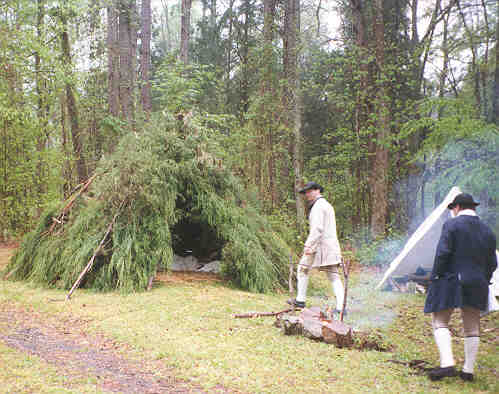
One type of brush hut (wigwam) constructed by British and Continental soldiers. After erecting a tripod of long poles (tied together at the top), additional poles are added to fill in the structure, and leaf-covered branches or pine boughs placed over them as a covering. (Photograph by John Rees, North Carolina Volunteers, Historic Stagville, April 1997.)
Brush huts were mentioned in several orders for the 2nd Battalion of Light Infantry in the weeks before the Battle of Germantown.
Bat[talio]n orders [19 September 1777]... Commanding officers of Companys will not Alow their Men upon any Pretence wath [sic] ever to quit their Arms, Except to make Wigwarms, without his Leave untill the Picquetts are Posted.
B.O. [26 September 1777, Germantown] The Companies [are] to make Wigwams as fast as possible, the Q[uarter]M[aste]r. Will attend & show [them] their Ground.5
Martin Hunter recounted that the advanced light infantry "had changed our quarters two days before [the battle] from the houses in Beggars-town to wigwams outside the town...
" At the onset of the Continental Army's attack "the battalion was out and under arms in a minute; so much had they in recollection Wayne's affair [i.e., the Battle at Paoli] that many of them rushed out at the back part of the huts." Another British officer wrote, "Octr 4th This morning at 6 O'Clock, we were attack'd at several different Quarters by ye Rebel Army... The 1st battln of Light Infantry was entirely Surrounded, their Wigwams, & provision Waggon in possession of the Enemy, 'till they fought their way thro' and retook them."6
While most of Howe's army took up quarters in and around Philadelphia after the Germantown battle, a large force under Lord Cornwallis was sent into New Jersey. Captain William Haslewood, 63rd Regiment, described the detachment's activities and the shelters used:
the 18th. Novemr [1777] the 63d with many other Regiments landed at Billins Port [New Jersey]... on the 22d the Army march'd to five Mile Bridge... Remaind one night Here in Wigwams and during our stay Collected 300 Head of fat Cattle and 1000 Sheep [On the] 23d We march'd to Newberry to join Ld Cornwallis, immediately on our arrival the 63d was order'd to red Bank a strong Reboubt the Rebels had abandoned the proceeding Night. The 26th., 33d, 63d and a Company of Guards remained here three nights in Wigwams and demolish'd the Works...7
After the year's campaigning seemed at an end one final sortie was made by the British occupying Philadelphia. Stemming from the need to gather food and forage to tide his troops over for the winter months, Sir William Howe sent most of his army into the Pennsylvania countryside south of the city. Captain Haslewood noted, "20th. Decem [1777] a large [part of the British] Army crosses over the [Schuylkill Bridge]... and advances 7 or 8 Miles Into the Country remains there for a Fortnigh[t] In Wigwams... great quantity of Forrage and Cattle were taken..."8 German captain Friedrich von Muenchhausen echoed this account:
[22 December 1777] In the morning General Howe marched with... 8,000 men in one column across the Schuylkill over the pontoon bridge which was constructed yesterday. With these troops he formed one line extending from the other side of this bridge to beyond Darby, seven miles from here, where our left wing deployed so as to cover the flank. About 500 wagons, which we had taken along, at once began foraging behind the line. Our men constructed temporary cover as well as they could. We did not have tents with us, as we almost never did during this whole campaign.9
The next widespread use of wigwams and huts by British forces occurred during the Monmouth Campaign in June 1778. After General Henry Clinton's forces completed the evacuation of Philadelphia, Captain John Peebles of the 42nd Regiment, noted, "Thursday [June] 18th [1778]... the Troops march'd to within 2 miles of Haddonfield where they Encampd in the usual manner, vizt. Wigwams..."10 German lieutenant John Charles Philip von Krafft left a detailed account of shelters used during the march across New Jersey.
[15 June 1778] It may have been 7.30 P.M. when we arrived there [at a place two and a half miles past Coopers Ferry]. As we had no tents and it was too late to build huts, I lay down under a tree to sleep.
[16 June] In the morning order was given to erect huts, because we were to remain here until all had overtaken us from Philadelphia.
[18 June]... we passed through the little town of Hottenfelt [Haddonfield], where, at about 8 o'clock, we who were on the extreme right camped under huts on a fallow field.
[20 June] At 3 A.M. we marched away again... during a heavy rain. Towards noon we built huts in a meadow near the town of Morristown [Moorestown]...
[21 June] From 3 in the morning until noon I had the rear guard of our and the English regiment, again in the heavy rain. In the afternoon we marched during the terrific heat... Our Grenadiers and the English, which were in front got into camp about 6.30 P.M., on the right in front of the town [of Mount Holly], in bush [huts], again in the wheat... This night there was a terrific thunderstorm and the rain poured down so hard that we in our bush-huts got very wet.
[22 June] About noon we again pitched our hut-camp on a meadow at Black Horse [Tavern]...
[23 June] At 4 A.M. we moved again, in the middle of the army, till towards evening when we again pitched our camp in a fallow field at Racklestown [Recklesstown]... [After leaving the encampment for a short time] we hastened toward our camp and [met]... in the woods that extend nearly up to our huts, some soldiers of our Company who were in search of wood...
[25 June] At 7 in the evening we reached... Frehold Township... and pitched our tents on a fallow field.
[26 June] At noon we... were near the little town of Freholdt... at a short distance away from the place... we pitched our camp in a fallow field... That evening there was a terrific thunderstorm... I lay in my hut, on account of the rain, leaning on my left arm, together with my orderly, when there was a fearful thunderclap, so that I could not help thinking my hut had been struck. But it struck at a distance of only 15 paces behind my hut...
[28 June] At 8.45 P.M. we camped at Notchwarb, in the midst of woods and on an elevation in a field of beautiful wheat. We postponed building our huts until the next day on account of our fatigue.
[30 June] At 7 A.M. we broke up our camp and marched through the borough of Mittletown... until we reached, two miles further on, quite a large hill where we pitched our camp... Huts were built, but owing to the heat, it was almost impossible to breath underneath them.11
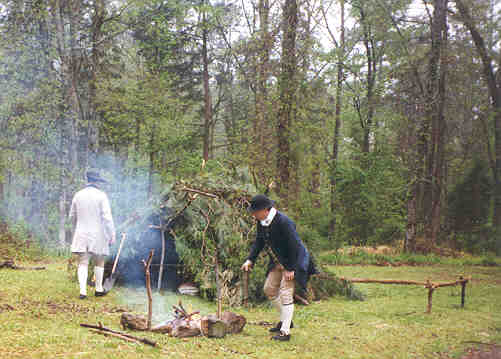
The British used wigwams only intermittently over the next year and a half, and then only by small detachments sent out occasionally. German private Johann Conrad Doehla of the Bayreuth Regiment described one such instance in June 1780: "We camped there [Philips' Point, New York]. Because of a shortage of tents, which were still in New York, and the great heat, we built huts for ourselves from branches with leaves."12
Beginning in 1779 the main British war effort shifted southward, but brush shelters were not widely used until the following year. After the destruction of General Horatio Gates' army at Camden on 16 August 1780, Lord Cornwallis determined to move north and clear North Carolina of Continental troops. On 1 October American General Jethro Sumner informed Gates, "Colonel Dickerson, who was on the Enemy's Lines yesterday... discovered 800 of them upon their march, three miles in advance from Charlotte... on the Road leading to Bety's ford on Catawba River, about 9 o'clock in the morning... it was given out they were to march in ten Days from Newbern; that they were building brush Hutts, their Lines were circumscribed close in the Town..."13
Operations continued through that winter, and after the Battle of Guilford Courthouse in March 1781 the British troops divested themselves of all excess baggage, including tents. One officer with the 76th Regiment later recalled of Cornwallis's 1781 campaign in Virginia, "Our encampments were always chosen on the banks of a stream, and were extremely picturesque, as we had no tents, and were obliged to construct wigwams of fresh boughs to keep off the rays of the sun during the day."14 Regimental orders for the 43rd Foot give additional evidence of the use of brush shelters that summer, this time in conjunction with tents:
[30 June 1781, Williamsburg, Virginia] The Officers Commanding Companies to see the Wig Warns made >as secure against Sun and Rain as possible.
[11 August] It is the Majors positive Order that the Soldiers of the Regiment shall sleep in either their tents or Wigwams.
[27 August, Yorktown] Commanding Officers of Companies will inspect the Mens Wigwams and report whether they are proper or not.
[9 September] The Major recomends it to the Soldiers to be in their Wigwams if Water-tight in preference to the tents.
[27 September] The Regt will leave the Wigwams Standing.15
On 30 September American surgeon James Thatcher noted, "We were agreeably surprised this morning, to find that the enemy had, during the preceding night, abandoned three or four of their redoubts, and retired within the town [Yorktown], leaving a considerable extent of commanding ground, which might have cost us much labor and many lives to obtain by force." Early in October he mentioned one of the abandoned British huts. "A large detachment of the allied army, under command of Major-General Lincoln, were ordered out last evening for the purpose of opening intrenchments near the enemy's lines... we were favored... with a night of extreme darkness... In the latter part of the night it rained severely, and being in the open field, cold and uncomfortable, I entered a small hut made of brush, which the enemy had abandoned. Soon after, a man came to the door, and seeing me standing in the centre, instantly drew his sword... I called out friend, friend, and he as speedily, to my great joy, responded, 'Ah, Monsieur, friend..."16
With the surrender of Yorktown, large-scale field operations came to an end. Brush huts continued to be used by both sides in the ensuing months but never again in the numbers seen earlier in the war.
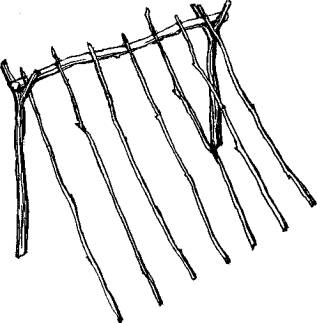
Sheds and brush huts were
also built in the form
of an open-faced half-shelter. (Illustration by Ross
Hamel)
Part II.
Building Brush
Huts
The first step in reconstructing a wigwam is to ascertain how soldiers built them. Unfortunately, there are only a few illustrations or detailed descriptions to guide us. The best-documented design consists of a long ridge pole supported by two upright forked tree limbs driven into the ground. Seventeenth-century English carpenters knew these supports as "Cratchets" or "crotchets." The "English crutch" is a variation on this design. In that method the ridge pole is placed on two sets of crossed poles tied together at the top to form supports. When using this form one end of the hut needs to be secured to an upright driven into the ground; it is possible that huts built this way were secured to a still-standing tree. (Several tent-shaped booths pictured in an original print of the Thames Frost Fair, circa 1739, were built with the "English crutch" method.) Simple open-faced lean-tos or wedge-shaped shelters can both be built using these methods. Continental soldiers are known to have used the cratchet form of construction. An American officer near Valley Forge in December 1777 lodged in a brush hut "made with two forked saplings, placed in the ground, another [sapling] from one to the other. Against this, fence-rails were placed, sloping, on which leaves and snow were thrown, and thus made comfortable." This method was also used for a wooden tent pictured in the 1788 German military manual, Was ist jedem Officier waehrend eines Feldzugs zu wissen noethig ("What it is necessary for each officer to know during a campaign").17
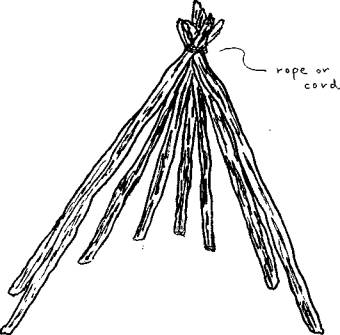
The basic structure of a
cone-shaped wigwam or brush hut
before the outer covering is added.
(Illustration by John Rees.)
Another wigwam type was cone-shaped, similar to huts built by early English colonists in America and those used as dwellings by goatherds, shepherds, and field workers in England for hundreds of years prior the eighteenth century. They also resembled conical living quarters built by charcoal burners and bark-peelers, probably also predating the eighteenth century. The American brush huts shown in the 1782 painting "The Battle of Paoli" by Xavier della Gatta, can be interpreted as either conical or A-frame in form. There are no accounts describing the construction of cone-shaped wigwams, but the form was well-known and simple to build. American Surgeon James Thacher may have alluded to conical wigwams with a low entrance and enough headroom to stand upright in the center when he referred to the abandoned British dwellings outside Yorktown: "I entered a small hut made of brush, which the enemy had abandoned. Soon after, a man came to the door, and seeing me standing in the centre, instantly drew his sword..."18
Structures similar to conical brush huts were recommended to cover camp kitchens in cold weather. In his 1768 System for the Compleat Interior Management and Oeconomy of a Battalion of Infantry, Bennett Cuthbertson noted, when "a Regiment is to remain very late in the Field... [it] will require many... precautions to make the Soldiers comfortable... in particular during the time of cooking, when the inclemency of the weather often renders it almost impracticable, in the open air; to obviate... [their] distress... young trees should be collected, about the size and length of hop-poles, and placed in a circular form round the out-side of the Kitchens, sloping upwards to a point, exactly in the same position, the poles are fixed... leaving a sufficient opening on one side, for the men to enter, and weaving small boughs or rushes through the poles: the Kitchens being defended in this manner, the Soldiers remain no longer exposed to the inconveniences of the weather; and are enabled, not only to dress their victuals, without the smallest interruption, but by making a large fire in the center of the Kitchen, to enjoy themselves in great comfort and satisfaction..." Cuthbertson also stated that "the allied Army in Germany last war [i.e., the Seven Years' War]" used "Kitchens of this construction." (The kitchens referred to were circular, earthen constructs, dug into the ground; Humphrey Bland's 1762 Treatise of Military Discipline gives twenty-nine feet as their "outer diameter." For more on excavated kitchens see, John U. Rees, "'As many fireplaces as you have tents...': Earthen Camp Kitchens," and "Matt and I Dig a Kitchen: Recreating an 18th-Century Cooking Excavation," Food History News, vol. IX, no. 2 (Fall 1997) and no. 3 (Winter 1998). See also The Continental Soldier (Journal of the Continental Line), vol. XI, no. 3 (Summer 1998), pp. 26-32.)19
The basic structure of a conical wigwam consists of three tree limbs or saplings (from eight to twelve feet long) tied together at their tops and then set up; to ensure they remain in place the bottoms of the poles can be dug slightly into the ground. More poles can then be added, and leaf-covered branches or pine boughs placed over the completed frame.
Among the many Continental soldiers who mentioned makeshift shelter, two left particularly interesting references. Joseph Plumb Martin's description is curious; he wrote of the Whitemarsh encampment in Pennsylvania, "we joined the grand army near Philadelphia, and the heavy baggage being sent back to the rear of the army, we were obliged to put us up huts by laying up poles and covering them with leaves, a capital shelter from winter storms." "Laying up poles" could refer to the fashioning of a tripod for a conical hut, or merely the leaning of cut limbs against a standing tree to form a crude shelter. Ensign John Markland, 6th Pennsylvania Regiment, tells of another form of makeshift shelter his soldiers built: "... from the Battle of Brandywine until their encampment near Skippack, they were constantly engaged in heavy, rapid, and severe marches, without tents or baggage. These articles having been sent far into the rear, their shelter at night being frequently nothing more then a few rails placed slantwise against a fence, with a few dry leaves, if they could be procured."20
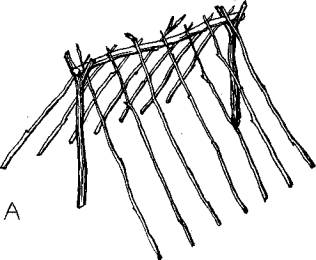
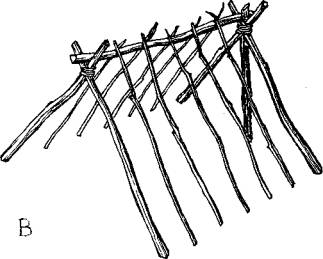
Another form of brush hut. Figure A. shows a long ridge pole supported by two upright forked sticks (called "Cratchets" or "crotchets"), driven into the ground; in figure B. the ridge pole is placed on two crossed poles tied together at the top to form a support (an "English crutch"). When using this last method one end needs to be secured to an upright driven into the ground. Either a simple lean-to or a wedge-shaped shelter can be built with these methods. (Illustrations by Ross Hamel.)
Finally, it is noteworthy that only British soldiers used the term "wigwam" to denote brush huts. To date I have found only one American account of soldiers' shelter, among scores, which contains the word, and that only as a derogatory reference to the winter log huts at Valley Forge. Wigwam originates from several Native American variations: Ojibwa, wigwaum, wigiwam; Algonquin, weekuwom, wikiwam; Delaware, wiquoam; all literally mean their house, my house, or his house. The term was used very early by English colonists in America; one of the first settlers of Massachusetts Bay, Edward Johnson, wrote that his compatriots "burrow themselves in the Earth for their first shelter under some Hill side, casting the Earth aloft upon Timber... in these poor Wigwames (they sing Psalms pray, and praise their God) till they can provide them houses." In 1631 Massachusetts Bay Lieutenant-Governor Dudley noted "some English wigwams... have taken fire in the roofs covered with thatch or boughs." For some reason the word fell out of general use in America but was retained by the British, or at least by British soldiers.21
Acknowledgments
Many thanks to Charles Beale, Steve Gilbert, Justin Grabowski, Kurt Hague, Ross Hamel, Chris Hughes, Charles LeCount, Garry Stone, and Mark Turdo for their contribution of information or help in brush hut reconstruction.
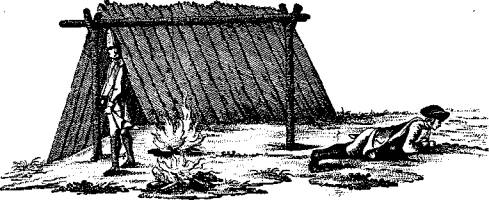
Wooden tent built with cratchet supports, pictured in the German military manual Was ist jedem Officier waehrend eines Feldzugs zu wissen noethig (trans., "What it is necessary for each officer to know during a campaign"), Carlsruhe, 1788. (Courtesy of Charles Beale.)
Notes
1. "brush Hutt". "Journal of Lieut. William McDowell of the First Penn'a. Regiment, in the Southern Campaign. 1781-1782", John Blair Linn and William H. Egle. Pennsylvania in the War of the Revolution, Battalions and Line 1775-1783. II (Hanisburg, Pa., Lane S. Hart, State Printer, 1880), 298-299; "bush housen," "buth" (booth), and "housan of branchis & leavs", Robert C. Bray and Paul E. Bushnell, eds., Diary of a Common Soldier in the American Revolution: An Annotated Edition of the Military Journal of Jeremiah Greenman. (DeKalb, Il., Northern Illinois Univ. Press, 1978). 87. 98 (note 131), 174; "hemlock bowhouses," Journal of Jehiel Stewart, 1775-1776, Revolutionary War Pension and Bounty - Land - Warrant Application Files, National Archives Microfilm Publication M804, reel 2290, W25138 (hereafter cited as Pension Files, NA); "huts [of] brush and leaves," "Journal of Ebenezer Wild," Proceedings of the Massachusetts Historical Society, 2nd series. VI (Boston, 1891), 105. Also, "brush huts", 27 June 1778 entry, Diary of Bernardus Swartout, 2nd New York Regiment, 10 November 1777-9 June 1783, Bernardus Swartout Papers, New York Historical Society. "bush hut... Covered... with Bark", 7 June 1779, Hudson Highlands: "... built a bush [brush] hut to dwell in." 9 June: "Covered our hut with Bark. At Night it Rained and I got Very Wet by Reason of the Huts not Turning the Rain." Rebecca Symmes, ed., A Citizen-Soldier of the American Revolution: The Diary of Benjamin Gilbert in Massachusetts and New York (Cooperstown, N.Y., The New York State Historical Assoc., 1980), 52.